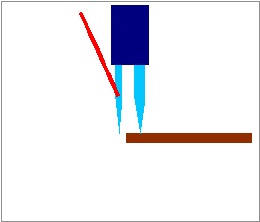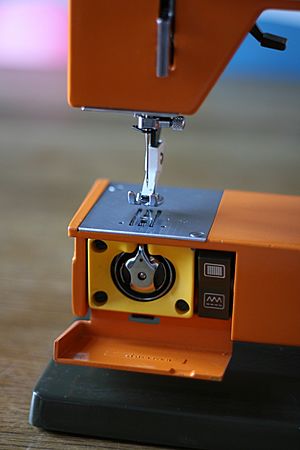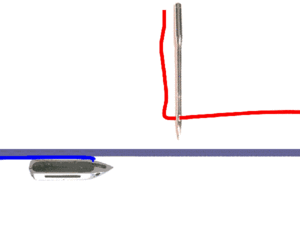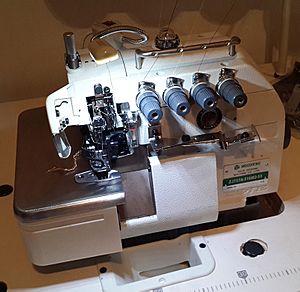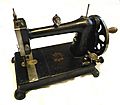Sewing machine facts for kids
A sewing machine is a cool tool that stitches fabric together using thread. It was a big invention during the Industrial Revolution, making it possible to sew much faster than by hand. Sewing machines are also used for embroidery, which is like drawing with thread.
The first working sewing machine was designed by Thomas Saint in 1790. Since then, sewing machines have greatly improved how clothes are made. They help make clothing production much quicker and easier.
Home sewing machines are made for one person to sew individual items. They usually use one type of stitch. Modern home machines make it easy to move fabric through without needing needles or thimbles, saving a lot of time.
Industrial sewing machines are different. They are bigger, faster, and come in many shapes and sizes. They are designed for specific tasks in factories.
Contents
How Sewing Machines Began
Early Ideas
The very first British patent for a sewing device went to Charles Fredrick Wiesenthal in 1755. He invented a special needle with an eye at one end.
In 1790, an English inventor named Thomas Saint designed the first sewing machine. He didn't sell it widely, but his machine was meant for tough materials like leather and canvas. It had many clever parts, like an arm that hung over the fabric and a way to feed the material.
Saint's machine used a simple chain stitch. This stitch uses only one thread. A sharp tool would poke a hole, and a rod would pull the thread through. Then it would hook the thread underneath for the next stitch. This machine was good for making things like saddles and bridles, and even ship sails. Later, in 1874, someone found Saint's drawings and built a working model.
In 1804, other inventors like Thomas Stone and James Henderson also built sewing machines. An Austrian tailor, Josef Madersperger, showed his working machine in 1814.
The First Practical Machines
The first truly practical sewing machine was invented by Barthélemy Thimonnier, a French tailor, in 1829. His machine also used the chain stitch. In 1830, he got a patent and opened the world's first machine-based clothing factory. It made army uniforms for the French Army. Sadly, the factory was burned down. Some say workers did it because they feared losing their jobs to the machines.
A model of Thimonnier's machine is in the London Science Museum. It was made of wood and used a special needle to pull thread through the cloth.
The first American machine to use a lockstitch was invented by Walter Hunt in 1832. His machine used two threads: one from a needle and one from a shuttle. The threads would interlock. Hunt didn't patent his invention until much later.
In 1844, an English inventor named John Fisher built a machine that combined many new ideas. It was very similar to the machines made by Isaac Merritt Singer in 1851 and Elias Howe in 1845. However, Fisher's patent paperwork had problems, so he didn't get the credit he deserved.
The Sewing Machine Wars
Elias Howe created his sewing machine in 1845. His machine held the fabric vertically. A key improvement was how his needle worked. After trying to get interest in his machine in England, he came back to America. He found many people, including Isaac Merritt Singer, using his ideas without permission. Howe won a lawsuit in 1854. This meant other manufacturers had to pay him money for using his patented ideas.
Singer saw a broken sewing machine and thought he could make a better one. His machine had a vertical needle and a presser foot to hold the fabric. He got an American patent in 1851. When Howe found out about Singer's machine, he sued him. Howe won, and Singer had to pay him for all the machines he had already made. Singer then paid Howe a fee for each new machine. They even started a special payment plan so more people could afford to buy their machines over time.
Meanwhile, Allen B. Wilson invented a better shuttle. He also created the "four-motion feed mechanism." This system moves the fabric forward, down, back, and up, pulling the cloth smoothly. This is still used on every sewing machine today! Wilson partnered with Nathaniel Wheeler to make machines with a rotary hook. These machines were much quieter and smoother. Their company, Wheeler & Wilson, made more machines than anyone else in the 1850s and 1860s.
Many companies were starting up in the 1850s, and they kept suing each other over patents. This period was called the "Sewing Machine War."
In 1856, the main companies, including Singer, Howe, Wheeler, Wilson, Grover, and Baker, decided to work together. They shared their patents. This meant other companies had to get a license and pay them money for each machine they made. This agreement lasted until 1877.
Sewing machines became very popular in homes by the 1860s. They cost about £6 to £15 in Britain. People, especially women, used them to make and fix clothes for their families. A sewing machine could make a man's shirt in about one hour, which used to take 14 and a half hours by hand!
In 1877, the world's first crochet machine was invented by Joseph M. Merrow. This was the first machine to make an overlock stitch. The Merrow Machine Company became a big maker of overlock sewing machines.
In 1885, Singer patented the Singer Vibrating Shuttle machine. It was a very practical machine for home use, and millions were made.
Electric Machines
The first electric sewing machines were made by Singer Sewing Co. in 1889. At first, they were regular machines with a motor attached to the side. As more homes got electricity, electric machines became more popular. Eventually, the motor was built right inside the machine.
Types of Sewing Machines
There are a few main types of sewing machines:
- Electric machines: These are powered by electricity and are very common today.
- Hand machines: These are operated by turning a crank by hand.
- Pedal/treadle machines: These are powered by pushing a foot pedal back and forth.
How Stitches Work
Sewing machines can make many different kinds of stitches. There are over thirty different stitch types! They can use one to seven threads to create a stitch.
The main types of plain stitches are chainstitch, lockstitch, overlock, and coverstitch.
Chainstitch
Early sewing machines used the chainstitch. It has two main problems:
- If the thread breaks, the whole line of stitches can easily come undone.
- You can't change the sewing direction much, or the stitch will fail.
Even with these problems, the chainstitch is still used today in clothing factories. It's often used with an overlock stitch to make seams stronger.
Lockstitch
The lockstitch is the most common stitch. Most home sewing machines and many industrial machines use it. It uses two threads: one from the needle and one from a bobbin underneath. Each thread stays on its own side of the fabric, but they interlock at each needle hole. This means a lockstitch can be made anywhere on the fabric, not just near an edge.
Overlock Stitch
The overlock stitch, also called "serging," uses two to four threads. It often has knives that trim the fabric edge right before the stitch is made. Overlock machines are great for stretchy fabrics or for finishing edges so they don't unravel. Machines with five or more threads can make a "safety stitch," which combines a chainstitch with an overlock stitch.
Coverstitch
A coverstitch uses two or more needles and one or two loopers. Like the lockstitch, it can be made anywhere on the fabric. One looper works below the fabric, making a bottom stitch. Another looper can work above the fabric, making a top stitch. This stitch is often used in clothing to attach trims or make flat seams.
Zigzag Stitch
A zigzag stitch is a type of lockstitch that goes back and forth. It's used when a straight stitch isn't enough. For example, it helps stop fabric from unraveling. It's also good for sewing stretchy fabrics or temporarily joining two pieces of fabric edge-to-edge.
The zigzag motion of the needle is controlled by a special part called a cam. As the cam spins, it moves the needle side to side. Older machines might not have this, but you can sometimes add a special attachment to make them do a zigzag stitch.
Images for kids
-
Elias Howe's lockstitch machine, invented in 1845
See also
 In Spanish: Máquina de coser para niños
In Spanish: Máquina de coser para niños



